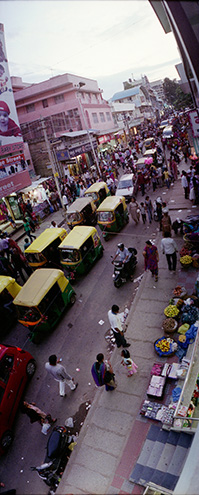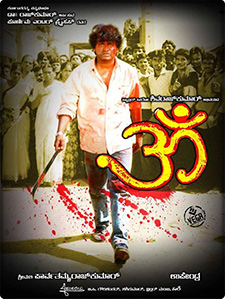What Kannada cinema taught me about my city.
Bangalore in Kannada Cinema
Photo by Muhammad Mahdi Karim used under GNU License Ver. 1.2
Filmmakers have often used a city or town as a canvas to narrate their story in, and in the process create works that become a snapshot of the life in them. Woody Allen’s love affair with New York is well known, European cinema of the neorealist kind relies heavily on the city as a backdrop to the various misfortunes of its characters. Closer home, while it isn’t as popular a style there have been notable outliers. A person walking in the rain on Marine Drive in Mumbai for example, would obviously remember Amitabh Bachchan and Moushumi Chatterjee doing the same. Satya and the looming cityscape shots that punctuate it offer a cynical if typically Mumbai view of the city. The world knows and fears bank robbers on superbikes thanks to that gripping docudrama Dhoom. More recently Kahani takes the central character and with her us, through Kolkata. As does Piku in the end, where an anal old man finds gastrointestinal catharsis in cycling through the lanes he once ran through as a kid and then smashing a half a dozen Kachoris.

My own initiation into movies and Bengaluru (bengaLooru to us) started with a lovely relationship Drama/comedy called Nodiswamy Naavirodu Heege (Well Sir, We are like this only). Written and Directed by Shankar Nag (henceforth referred to as The Nag); a man known to everyone as the maker of the Malgudi Days TV series, the movie is a detailed but pleasing mural of the city from 1983. The title song for example, shows our protagonist in different parts of the city, blending in and just being. He’s eating peanuts by the lake with a bunch of senior citizens, shaking a leg at Waikeekee with friends, doting on his nephew, helping his neighbours with daily chores and the rest of the city seems to be doing much the same. The song establishes a certain sameness he feels with the others, and is telegraphed as such in the lyrics. It’s not all hunky dory though, the lead female character is harassed on the street in broad daylight and true to life she has to brush it off. When she introduces to her parents a man she wishes to marry, her father pointedly identifies his caste and makes no effort to hide his disgust. All of this is handled lightly, keeping with the popular tone of the film. The same team from Nodiswamy also made the deeply disturbing Accident in 1985. Written by Vasanth Mokashi, Accident is the tale of two kids of influential people in the city – the son of a powerful politician and the other his friend,whose mother runs an advertising agency. Together one inebriated night they drive their swanky car over pavement dwellers, killing all but one of them and then flee from the scene. What follows next is an elaborate coverup by the two parent figures. As a kid, for the first time I saw Bangalore to be a confusing, dangerous place. The disparity between the haves and have-nots is deftly handled but always in your face. Two scenes strongly stand out to me, that are interesting pictures of urban life. The opening titles itself are a terse series of typed out text, similar to what Maniratnam uses in Guru, and sets the tone for the gritty drama that is to follow. In a drive through montage we see two men driving around the city with contempt for its lesser privileged citizens. We then move into a hep house party where they walk in with copious amounts of weed. (we will not go into the specific politics and opinions of Marijuana). The party itself shows a group of young people giddy in hedonistic pursuits making for some wry, interesting dialogue. And then the last scene. In The Nag’s Bangalore, the subaltern does not just speak – it rises and takes revenge. When the film ends, Deepak’s face tilts to a side, blood dripping on his lifeless cheek ; and you walk away shaken, thinking of humanity and its ugliness,

The preferred genre of that time it seems, was Social drama. The 80’s also gave us Mani Rathnam’s Directorial debut Pallavi Anupallavi (1983), in which Anil Kapoor and Kiran Vairale frollick in each other’s company around Bangalore. Rajnikanth was a real-life bus conductor in our city, and in what I’m convinced is a tip of the hat to him, Kamal Hassan plays a sparkling cameo in Benkiyalli Aralida Hoovu (also 1983) extolling the virtues of Public Transport as a singing bus conductor. Other notable portraits of Bangalore from the time include the poetic Pushpaka Vimana (1987, Singeetham Sreenivasa Rao, Kamal Hassan, Amala), a film with no spoken word but much said. While not as brutal as Accident, Pushpak (as it’s called in it’s Hindi certification) is about an individual’s search for a means to live, a purpose and love in a burgeoning city – all set against the backdrop of economic disparity and urban anonymity. There’s a scene where seemingly decent citizens are moving the corpse of a beggar, but throw it aside when they realise there’s wads of cash under his mat for the taking. In that scene, the protagonist and the audience both squirm at the unfairness of it all.
The turn of the decade saw Kannada cinema turning Social drama towards irony and satire. Films like Ganeshana Maduve (1990), Udbhava (1990), Gowri Ganesha (1991), Yaarigu Helbedi (1994) all showcased the comedy and brilliance of Ananth Nag (brother of The Nag) as he navigated the city with wit and extremely flexible morals. The humour regularly punched-above from the all too relatable platform of middle class angst. A new gaze also took form in Kannada cinema during this time. The Police. So well did the Kannada audience take to this superhero in Khakhi format that every lead actor of the time played an honest cop with undoubtable integrity, challenged by crimelords and lovers alike. The movies Sangliyana (1988) and SP Sangliyana (1990) with The Nag playing the lead role were superhits and curried enough popularity with the masses for the people of Bangalore to even elect into Parliament the real-life supercop H.T. Sangliana, on whose life the films were loosely inspired by.

In his book “Bipolar Identity: Region, Nation, and the Kannada Language Film”, MK Raghavendra traces the journey of Kannada cinema and its aesthetic from the 50’s to the 2000’s. He discusses the Identity of the Mysore state, its marked presence in the early decades to its gradual fade and disappearance in the mid 90’s. It is at this time we see a surplus of Rowdy and Gangster themed films, replete with violence and misogynist machismo. Mr. Raghavendra underlines the pattern of breaking out of the older depictions of mores as a search for a new identity. Nowhere is this more evident than in the film that started the flood, Om (1995) starring Shivarajkumar, Directed by Upendra. While we had seen the morally flexible hero, Om was perhaps the breakout film for the proper Anti-hero protagonist. The director takes us through the transformation of a god fearing, studious man into a feared, violent underworld don – a grotesque creation of the city he is in. A slew of gangster flicks were made in the following decade, and it is my opinion that around this time, Kannada cinema fell behind in the treatment and depiction of female characters, as well as those characters that weren’t the macho, male protagonist. (There are some wonderful exceptions, but I speak of the norm) While over the 2000s we got to see the vulnerable, pluviophile, romancing male who would do great on Tinder, the women are seen to be more and more straightjacketed into Mothers, Sisters, Damsels-in-Distress and occasionally the Vamp. Even the city starts to resemble a series of plastic malls and fancy cars alternated with beautiful mountain getaways. Of late thankfully, there is emerging a trend of more detailed depictions of city life, of not just Bangalore, but other cities as well. Perhaps this is popular media redefining the Urban Kannadiga identity, like in Pavan Kumar’s “U-Turn” (2016), an intern (played by Shraddha Srinath) with a newspaper tries to get to the bottom of a series of similar deaths in the city. She’s shown to be a fiercely independent, single woman living in an apartment.Or in Raj B Shetty’s lovely, body positive “Ondu Motteya kathe” (2017) set in Mangalore, a bald man played by Raj himself tries to find love. Suri’s “Kendasampige” (2015) still underlines the city as an intimidating space for the lesser privileged but is nuanced in its depiction of the darker elements. They certainly make one excited for the times and the films to come.
While this is but a small piece on Bangalore and Kannada cinema, to the uninitiated the larger Kannada canvas has a lot to explore. From the literature based cinema of the 70’s and 80’s to the powerful melodrama of Puttanna Kanagal our first superstar Director; Vishnuvardhan’s sophisticated machismo, Ambareesh’s rugged swag, the sheer brilliance of Kalpana, Manjula, Sarita; the cerebral humour of Kashinath and his protege Upendra. Several generations now have romanced to Hamsalekha’s tunes. All of this of course, encompassed by the versatile acting genius of our Matinee idol Dr. Rajkumar. Now if you still find yourself not looking up Kannada films this weekend, you need a Malashree’esque roundhouse kick to motivate you.
